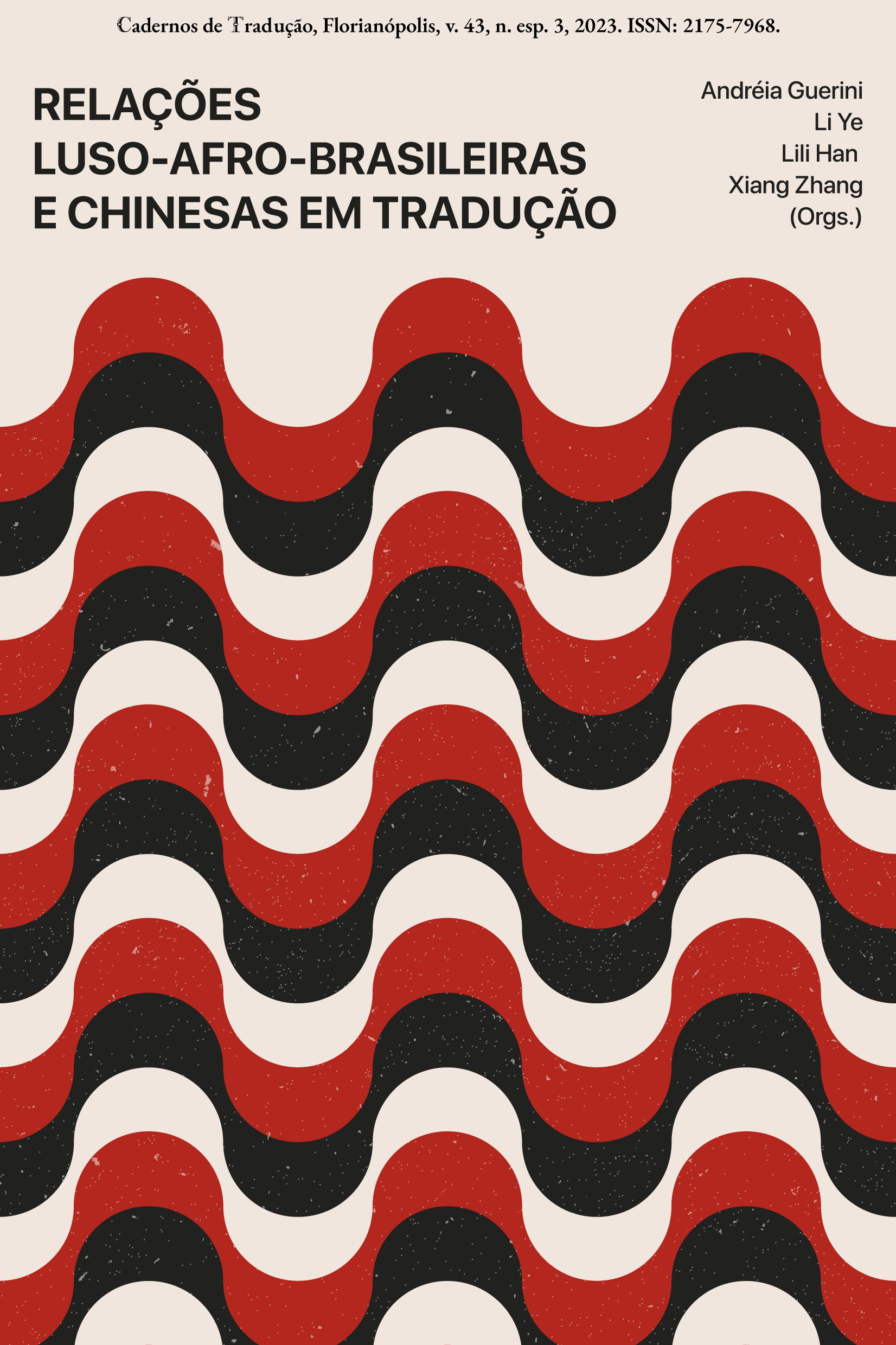As correspondências e não correspondências entre a língua e cultura chinesa e lusófona: análise de termos da botânica
DOI:
https://doi.org/10.5007/2175-7968.2023.e94952Palabras clave:
tradução, língua chinesa, língua portuguesa, hiperônimo, pragmáticaResumen
Apesar de pertencerem a duas famílias linguísticas totalmente distintas, encontra-se sempre uma traduzibilidade entre a língua chinesa e portuguesa. O primeiro dicionário Português-Chinês de Matteo Ricci e Michele Ruggieri do século XVII é a evidência mais persuasiva desse fato. Por um lado, não há carência de obras-primas de tradução nos dias de hoje e, por outro lado, o intercâmbio cultural intensifica-se a ritmo acelerado à medida que o processo de globalização se aprofunda. Torna-se premente prestar atenção à existência de diferenças existentes nas duas culturas diferentes e às não correspondências na sua tradução. O conhecimento parcial em relação a outra cultura pode originar uma tradução imprecisa e resultar em equívoco a respeito de outros conceitos associados em sequência. É indubitável que as diferenças de espécies biológicas e culturais são as que mais causam o fenômeno da não correspondência. Todavia, a procura de conceitos similares na cultura da língua de chegada é igualmente uma estratégia frequentemente utilizada, facilitando tanto o trabalho de tradutor, quanto a compreensão do público-alvo. Porém, a facilitação da tradução pode trazer mal-entendidos. No entanto, a não correspondência relativamente a hiperónimos e hipónimos entre as duas culturas dificulta, de certo modo, a tradução de alguns conceitos. O presente trabalho pretende exemplificar algumas das questões de não correspondências entre as duas línguas, com o objetivo de contribuir para a melhor compreensão entre a língua chinesa e portuguesa.
Citas
Dalgado, Sebastião Rodolfo. Glossário Luso-Asiático. Coimbra: Imprensa da Universidade, 1919.
Franco Aixelá, Javier. “Itens culturais-específicos em tradução”. Tradução de Mayara Matsu Marinho & Roseni Silva. In-Traduções, 5(8), p. 185-218, 2013.
Jatobá, Júlio Reis. “Poéticas do Traduzir a, na e para a China: uma proposta”. Cadernos de Tradução, 39(esp.), p. 120-147, 2019. DOI: https://doi.org/10.5007/2175-7968.2019v39nespp120
Kirschner, Roland & Hsieh, Shelley Ching-yu. “Ginkgo, Apricot, and Almond: Change of Chinese words and meanings from the kernel’s perspective”. Ethnobotany Research & Applications, 10, p. 321-328, 2012.
Lang, Sida & Sun, Yuqi. “Estranhamento como estratégia de tradução: categorização do estranhamento na poesia leminskiana e a sua recriação na língua chinesa”. Cadernos de Tradução, 40(3), p. 154-186, 2020. DOI: https://doi.org/10.5007/2175-7968.2020v40n3p154
Li, Yanmei & Liu, Qinglin. “Prunus mume: History and culture in China”. Chronica Horticulturae, 51(3), p. 28-35, 2011. https://www.ishs.org/chronica-horticulturae/vol51nr3
Mai, Ran. Ensino de Chinês a Falantes de Português: O caso da Universidade de Aveiro. Tese (Doutorado em Linguística). Departamento de Línguas e Culturas, Universidade de Aveiro, Aveiro. 2012. http://hdl.handle.net/10773/9842
Martins, Sabrina de Cássia. “A variação denominativa na terminologia da fauna e da flora: (as)simetrias linguístico-culturais”. Cadernos de Tradução, 38(2), p. 241-262, 2018. DOI: https://doi.org/10.5007/2175-7968.2018v38n2p241
Mao, Dun. “Sobre os métodos da tradução de livros literários”. Tradução de Ye Li. Cadernos de Tradução, 39(2), p. 379-388, 2019. DOI: https://doi.org/10.5007/2175-7968.2019v39n2p379
Wang, Suoying. Lexicultura na Língua Chinesa e na Lexicografia Bilingue de Chinês-Português. Tese (Doutorado em Linguística, especialização em Lexicologia, Lexicografia e Terminologia). Faculdade de Ciências Humanas e Sociais, Universidade Nova de Lisboa, Lisboa, 2015. http://hdl.handle.net/10362/17164
Wang, Suoying & Lu, Yanbin. “Equivalência contextual na tradução entre Chinês e Português: análise de alguns casos concretos”. Diacrítica, 34(3), p. 156-179, 2020. DOI: https://doi.org/10.21814/diacritica.553
Wu, Zhongwei. (Org.). Chinês Contemporâneo. 3. ed. Beijing: Sinolíngua, 2015.
Xīn huá zì diǎn [Dicionário Xinhua]. 10. ed. Beijing: Shāng wù yìn shū guǎn [The Commercial Press], 2004.
Zhang, Jianbo & Lou, Zhichang. “Tradução das palavras com carga cultural no romance 活着 (huó zhe, Viver) a partir da perspectiva da eco-translatologia”. Cadernos de Tradução, 43(1), p. 1-22, 2023. DOI: https://doi.org/10.5007/2175-7968.2023.e86532
Jin, Guoping金国平. “葡萄牙语和西班牙语中关于“松江布”的记载及其吴语词源考” [g(c)anga”as Recorded in Portuguese and Spanish and Investigation into Its Origin in Wu Dialect]. 史林[Shi Lin] (01), p. 52-60, p. 220, 2015.
Zhang, Jiao张姣. “说‘醋’” [Falar sobre “cù”]. 文教资料 [Wenjiao Ziliao] (Z1), p. 56-58, 2017.
Descargas
Publicado
Cómo citar
Número
Sección
Licencia
Derechos de autor 2023 Cadernos de Tradução

Esta obra está bajo una licencia internacional Creative Commons Atribución 4.0.
Declaración de Derecho de Autor
Los autores conservan sus derechos de autor y conceden a la revista el derecho a la primera publicación bajo la Licencia Creative Commons Attribution, que permite que se comparta el trabajo reconociéndose la autoría y publicación inicial en esta revista.
Los autores están autorizados a asumir contratos adicionales por separado para la distribución no exclusiva de la versión del trabajo publicada en esta revista (por ej.: publicar en un repositorio institucional o como capítulo de libro, reconociéndose la autoría y publicación inicial en esta revista).





















































